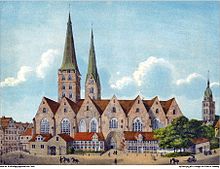Friedrich Ludwig Heinrich Waagen
also Christian Friedrich Ludwig Heinrich Waagen, Wagen or Wage) was a German portrait, history and landscape painter born in the Holy Roman Empire.
However, he had acquired extensive knowledge of art, amassed a collection of paintings in Hamburg and was known to friends with or in-laws of many important personalities of his time.
[1] Also preserved is a family album by Johann Thomas Ludwig Wehrs (1751-1811), in which Waagen registered himself on 17 October 1770 and also left a pen and ink drawing "Allegory of Science" in it.
[2] Waagen also had private lessons in 1770 in the studio of Johann Heinrich Tischbein the Elder, training in portrait and history painting.
He is also said to have been a pupil of Ferdinand Kobell (1740-1799), choosing landscape painting as his subject and taking Nicolas Poussin (1594-1664) as a model.
[4] From 1778 to 1779, Waagen studied at the Kunsthochschule Kassel, founded in 1777, where Johann Heinrich Tischbein the Elder was also a professor of Drawing and Painting.
The charcoal drawing showing Gottfried August Bürger at a reading and Waagen's oil painting depicting the Oppermann brothers, the physician Johann Heinrich Jäger and the painter himself were also created during this period.
Their circle of friends and supporters included, among others, Friedrich Gottlieb Klopstock (1724-1803) as well as the young Johann Heinrich Voß (1751-1826).
The Protestant church had no interest in commissioning altarpieces, and there was also a lack of courtly patrons for representative history paintings.
[17] At that time, his collection of paintings already comprised "54 of the choicest masters' pieces of all schools", as Philipp Otto Runge (1777-1810) mentioned in one of his letters in December 1804.
In October 1804, Waagen approached the city of Hamburg with a request to provide him with works from the cathedral slated for demolition for his art education purposes.
[18] A pupil of this school of drawing and painting was also Johann Joachim Faber (1778-1846), before he left for a study trip in Europe.
[20] Shortly after the death of his wife Johanna Louise, in the summer of 1807 Waagen offered her still unmarried sister Maria Alberti [de] (1767-1812) to marry her.
[18] Lediglich vier große Tafeln, Seitenflügel des Hauptaltars, befinden sich heute im Warschauer Nationalmuseum.




